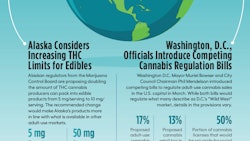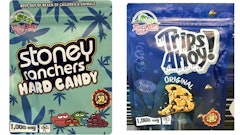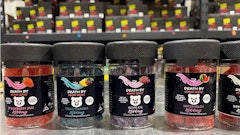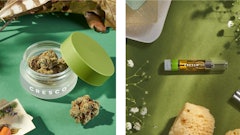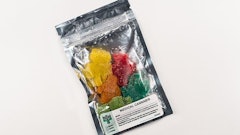

Cannabis-infused edibles present a tantalizing product opportunity for operators looking to expand the variety of options they offer. After all, procuring common baking ingredients can’t be nearly as difficult as cultivating a federally controlled substance like cannabis, can it?
In fact, manufacturing edibles can be a daunting supply chain challenge, even for cannabis companies that already have stringent quality controls in place. The complexity of sourcing high-quality ingredients from bulk suppliers, while complying with nascent regulations and industry best practices, can be convoluted.
“There’s some good, bad, and ugly associated with edibles production,” says Rob McCourt, vice president of Firelands Scientific, a vertically-integrated medical cannabis company in Huron, Ohio. “It’s good because edibles help round out other cannabis product options. The bad is the inconsistency that patients have experienced with edibles. And the ugly, of course, is the lack of harmonized rules around the ingredients. It’s often up to the producer to be transparent about certain inputs.”
While the edibles market is ripe for growth as the legalized cannabis industry expands, this space is also rife with risk. Cannabis Business Times spoke with edible producers about the food manufacturing challenges they’ve encountered and their advice for finding, vetting, testing, and scaling with bulk suppliers.
1. Start Local.
Marni Meistrell doesn’t have to look far to find flavorful ingredients that inspire edible products like Superfruit Gummies at Tropizen, the cannabis cultivation and production company she owns with her husband in Puerto Rico. Her best advice for sourcing bulk supplies: Start local.
“The flavors that are native to Puerto Rico are our most popular,” she says, like quenepa, which is also known as Spanish lime, and guanabana, or soursop. Both tropical fruits are popular for their potential as natural remedies—which is another quality Meistrell looks for in edibles ingredients.
RELATED: Tropizen Finds Success in Puerto Rico's Cannabis Market
However, the limited availability of seasonal fruit and specialty items can become a sourcing nightmare. “Quenepas are only in season once a year, and it’s not a commercial crop, so you’re not going to find them in the grocery store,” says Meistrell, who works directly with local farmers to source thousands of pounds of fresh fruit, which Tropizen processes in bulk to last all year. “Last year, guanabana was trending because it’s known for helping with cancer, so it became very popular and expensive. We had to search a little harder to find it, and we were willing to invest in that search.”
The seasonality of rare ingredients can add to the appeal of products like Pique, Tropizen’s cannabis-infused hot sauce, which contains a caballero pepper that grows on the island but isn’t commercially available.
While local flavors can help edible products stand out, producers might have to search beyond borders in order to find the best. “Many ingredients that we need for our products aren’t made here,” Meistrell says, like the blueberries Tropizen buys for its wild blueberry gummy. Because she can’t just drive to a nearby farm to check out every product, she’ll “buy small amounts from multiple suppliers, and test them out to determine what looks and tastes the best,” she says. “The best tip is to try as many samples as you can.”
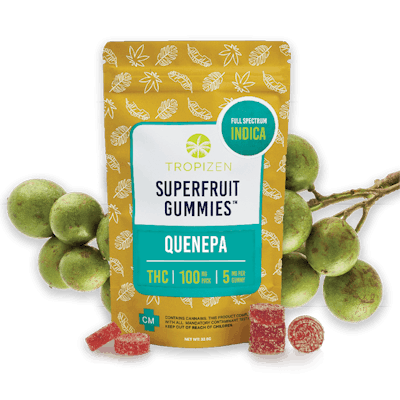
2. Go Above and Beyond Quality Standards.
While individual state cannabis programs regulate many of the standards for manufacturing infused edibles and testing both raw ingredients and final products, proactive producers go beyond to apply best practices from federally regulated industries, as well.
Rino Ferrarese and his team at CTPharma, a medical cannabis operation in Connecticut, entered the edibles market with a pharmaceutical approach to ensuring quality throughout every step of the manufacturing process. This includes a rigorous pharmaceutical-based quality management program with documented standard operating procedures (SOPs) that comply with the requirements of the FDA’s current Good Manufacturing Practices (cGMPs) for the food, drug, and cosmetic industries. The company also complies with Hazard Analysis Critical Control Point (HACCP), a federal food safety management system.
“Basically, all of the standards we use to manufacture our edibles are standardized processes adopted from existing consumer packaged goods industries,” says Ferrarese, president, COO and co-founder of CTPharma. “We culled our previous experience from manufacturing backgrounds, then coupled that with quality management standards like ISO 9001 (International Organization for Standardization, which establishes standards to help improve efficiency, reduce product failures and more), and married that all with our state’s medical marijuana regulations.”
Likewise, Firelands Scientific implemented cGMPs and HACCP to control manufacturing processes at its facility, which spans a 25,000-square-foot cultivation greenhouse connected to a 55,000-square-foot building that houses processing and manufacturing.
“We’re ultimately following FDA and USDA guidelines, although we aren’t subjected to them yet,” McCourt says. “In anticipation of that becoming a reality in the future, we have already constructed processes and compliance checks in alignment with the federal regulations for traditional food manufacturing.”
3. Vet Vendors.
CTPharma’s rigorous quality controls include processes for evaluating suppliers against the company’s high standards. To that end, CTPharma examines potential vendors by reviewing their operational standards and quality management processes, either through an on-site inspection or a detailed questionnaire.
“It’s critical to thoroughly vet your suppliers and make sure you know who you’re working with,” Ferrarese says. “You have an obligation to your customer to make sure that the ingredients being sourced meet standards of purity, identity, composition, and quality. There needs to be transparency in the supply chain.”
For example, Ferrarese prefers ingredients that are “lot traceable,” so he looks for vendors with systems that can “track and trace” ingredients from the original source all the way to the end-product.
Firelands Scientific looks deep into its vendors’ business practices to evaluate factors like environmental responsibility, community service, and employee benefits, in addition to quality controls. “With any partnership we forge, we look for mission alignment first,” McCourt says. “Ultimately, we want to work with good companies who treat their employees well, take care of the environment, and value the impact they have beyond their bottom line, like we do.”
In the community-focused cannabis industry, shared values can be a key factor in vetting potential vendors. These partnerships can also be important to conscious consumers. But ultimately, the selection depends on product quality.
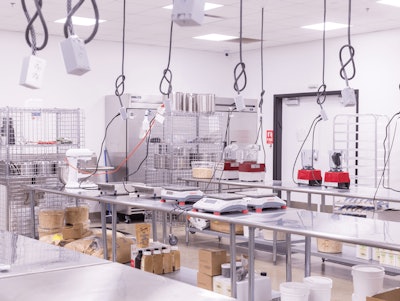
4. Test Product Quality Before Approving Suppliers.
Before vendors make it onto CTPharma’s approved supplier list, their products must pass a series of tests to ensure that each ingredient meets the company’s pharmaceutical-grade standards for its edibles, which include an infused baking mix, olive oil, honey, and a drink mix.
“When we first evaluate a vendor, a good rule of thumb is three lot validation,” Ferrarese says. “The first three batches or lots of raw material you get from a supplier, you want to put through full-release testing before you approve the vendor for use.”
Full-release testing at CTPharma includes internal evaluation of ingredients against a set of raw material specifications, which may include factors like color, consistency, smell, taste, weight, and moisture content. The company then sends samples to a third-party lab for further analysis of pH levels, chemical residues, and other microbiological properties. Only after receiving a certificate of analysis (COA) verifying an ingredient’s purity—consistently over three separate batches—will CTPharma approve a new supplier.
The testing philosophy at Firelands Scientific is to “trust but verify,” says McCourt, who learned the hard way that product-level certifications like “organic” don’t necessarily pass muster in the cannabis industry. The producer originally planned to develop healthy edible options like vegan fruit leather and organic granola, but encountered challenges sourcing organic fruit.
“When we set out to source ingredients, what we found was a lot of variability,” he says. Even fruit that was certified organic “had pesticide content in excess of what’s allowed in the Ohio medical marijuana program, so we decided that it wasn’t feasible to produce fruit leather.”
Instead, Firelands introduced Sun Bites, a traditional infused gummy made with all-natural, vegan, gluten-free ingredients. “The goal of our supply chain analysis is to verify that we’re working with quality partners who provide consistent quality inputs,” he says.
5. Plan For Growth.
After securing quality ingredients from reliable vendors, the next challenge is maintaining a steady supply. Barring disasters like the COVID-19 pandemic, which disrupted supply chains in nearly every industry, producers must plan ahead to ensure consistency.
“Speak with suppliers early on about scaling,” Meistrell advises. “We went from buying small bottles of natural flavor extract, for example, to ordering gallons at a time. When we needed larger quantities, we had to switch suppliers because they couldn’t provide enough product or give us a bulk discount. That’s something you don’t think of in the beginning.”
Sophisticated resource planning strategies help Firelands Scientific forecast its procurement needs based on predicted market shifts, product sales, and other trends.
“To ensure a consistent supply, we tightly tie our production and procurement motions to our sales forecasting,” McCourt says. “That allows us to accurately predict the sell-through velocity of edibles to ensure that we’re not under- or oversupplied, so there are no gaps in the medicines that our patients rely on.”

6. Innovate and Differentiate.
With a solid supply chain in place, the possibilities for growth and innovation in the edibles space are endless. Although McCourt doesn’t expect the sales of edibles to overtake larger cannabis categories like flower, cartridges or concentrates, he does anticipate continued growth.
Specifically, he sees opportunities to develop healthier edible alternatives for patients demanding vegan and gluten-free options. In fact, Firelands Scientific plans to relaunch its organic granola, which it paused due to sourcing challenges, when its new dispensary opens this spring, with more healthy products slated to hit the market by the end of May.
Meistrell, likewise, sees increasing interest in wellness-focused specialty products, like gummies formulated for sleep, immunity, or even romance. For example, Tropizen is releasing new varieties of Betty’s Eddies from multistate cannabis operator MariMed this spring, including a passionfruit-flavored aphrodisiac formula called Smashin’ Passion and ElderBetty chews, a product made with elderberry and fortified with zinc and vitamin D. Tropizen’s edible revenues have more than doubled over the last year, and Meistrell expects the ongoing pandemic to continue fueling the demand for healthier edibles.
CTPharma also has big plans to expand its edible offerings after moving from a 17,000-square-foot building into a new, 216,000-square-foot facility last year—complete with a full commercial kitchen. The company will launch a line of baked goods later this year, with the first products dropping in early summer and the rest hitting the market by year end.
“At the end of the day, this is something people are ingesting, so you want to make sure that everything is of the quality that people would expect,” says Steve Cancel, CTPharma’s creative director. “When you buy a Hershey bar, it always looks and tastes the same. You know exactly what you’re going to get, and our products should meet those same standards to give consumers a consistent experience.”








